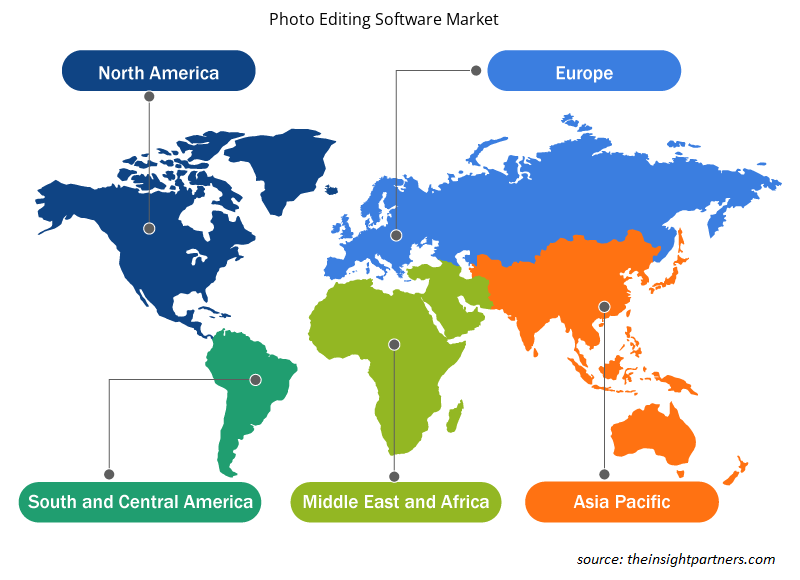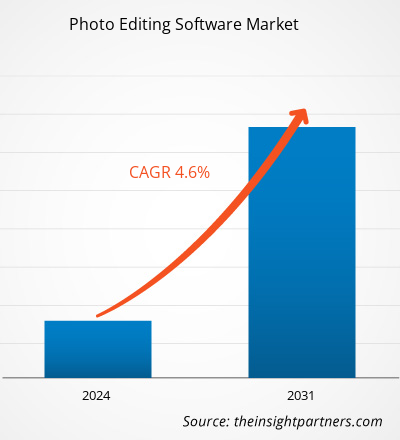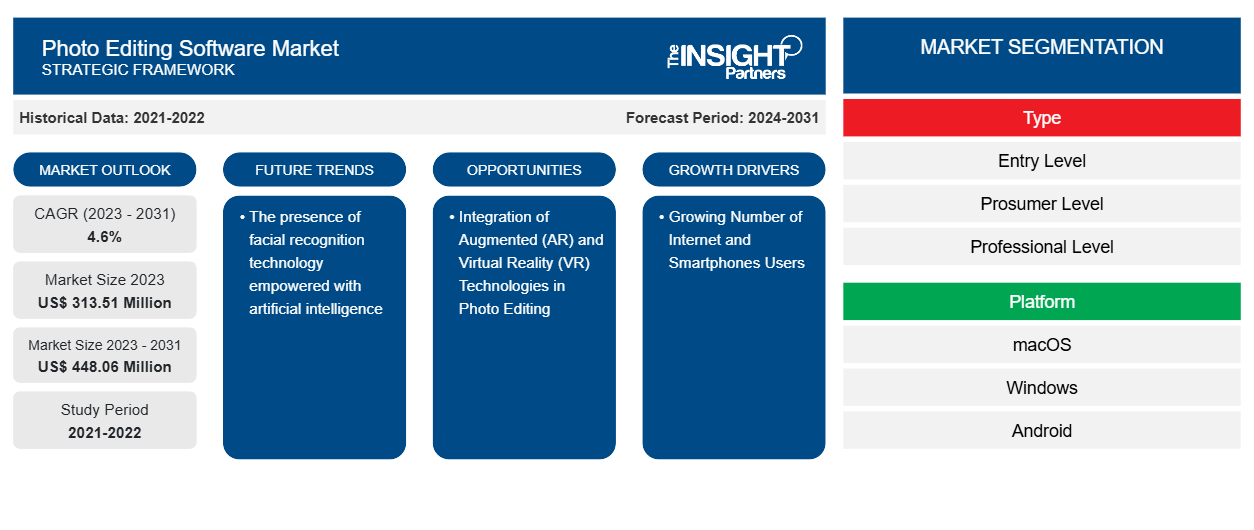Si prevede che la dimensione del mercato del software di fotoritocco raggiungerà i 448,06 milioni di dollari entro il 2031, rispetto ai 313,51 milioni di dollari del 2023. Si prevede che il mercato registrerà un CAGR del 4,6% nel 2023-2031. La presenza della tecnologia di riconoscimento facciale potenziata dall'intelligenza artificiale rimarrà probabilmente una tendenza chiave del mercato del software di fotoritocco.CAGR of 4.6% in 2023–2031. The presence of facial recognition technology empowered with artificial intelligence is likely to remain a key photo editing software market trend.
Analisi di mercato del software di fotoritocco
Il mercato dei software di fotoritocco sta crescendo a un ritmo rapido a causa del crescente numero di utenti di Internet e smartphone e della crescente domanda di fotografie digitali tra i consumatori. Il mercato si sta espandendo costantemente, spinto dalla crescente necessità di immagini di qualità ad alta definizione da usi individuali e commerciali. Inoltre, l'integrazione delle tecnologie di realtà aumentata (AR) e virtuale (VR) nel fotoritocco e il crescente utilizzo di algoritmi computazionali nei software di fotoritocco stanno offrendo opportunità redditizie per la crescita del mercato. VR) technologies in photo editing and the rising usage of computational algorithms in photo editing software are providing lucrative opportunities for market growth.
Panoramica del mercato del software di fotoritocco
Il software di fotoritocco è un'applicazione fotografica digitale che consente agli utenti di ritagliare, riparare e organizzare le proprie foto in base alle proprie esigenze. Il software può acquisire fotografie scansionate di vecchie pellicole fotografiche e convertirle in immagini digitali. Queste immagini vengono ulteriormente restaurate digitalmente rimuovendo i difetti e migliorando la qualità dell'immagine. La richiesta di effetti speciali nelle foto, tra cui colore, tinte, orientamento dell'immagine, fotografie digitali e modifica a strati, tra gli altri, sta alimentando il mercato per tutto il periodo di previsione.
Personalizza questo report in base alle tue esigenze
Riceverai la personalizzazione gratuita di qualsiasi report, comprese parti di questo report, o analisi a livello nazionale, pacchetto dati Excel, oltre a usufruire di grandi offerte e sconti per start-up e università
-
Scopri le principali tendenze di mercato in questo rapporto.Questo campione GRATUITO includerà analisi di dati che spaziano dalle tendenze di mercato alle stime e alle previsioni.
Driver e opportunità del mercato del software di fotoritocco
Il crescente numero di utenti di Internet e smartphone sta guidando il mercato
Un numero crescente di Internet aumenta la domanda di smartphone tra i consumatori in tutto il mondo e sta guidando il mercato. Internet e gli smartphone sono due dei fattori principali che alimentano il mercato. Il numero crescente di utenti di smartphone è associato all'influenza dei social media, aumentando la domanda di software di fotoritocco tra i consumatori. Inoltre, la crescente popolarità degli smartphone incoraggia i venditori del mercato a sviluppare software di fotoritocco specificamente progettati per gli smartphone. I produttori di smartphone stanno anche integrando le funzioni di modifica delle immagini direttamente nell'app della fotocamera principale, consentendo agli utenti di ispezionare, modificare e gestire il bilanciamento della luce e gli effetti di esposizione delle foto delle loro foto in tempo reale. L'aumento della capacità della fotocamera e della potenza di elaborazione degli smartphone sta spingendo i produttori a produrre applicazioni di modifica delle immagini mobili superiori, alimentando quindi il settore.
Integrazione delle tecnologie di realtà aumentata (AR) e virtuale (VR) nell’editing fotografico: un’opportunità nel mercato del software di fotoritoccoVR) Technologies in Photo Editing – An Opportunity in the Photo Editing Software Market
L'integrazione delle tecnologie di realtà aumentata e realtà virtuale nel fotoritocco consente agli utenti di applicare effetti più realistici alle immagini acquisite, rendendole più accattivanti. Inoltre, l'utilizzo delle tecnologie AR e VR fornisce un'immagine esatta e realistica dell'immagine migliorandone la qualità, il che aumenta la domanda tra i consumatori e crea opportunità nel mercato. Inoltre, l'utilizzo della tecnologia AR nel fotoritocco consente agli utenti finali di aggiungere effetti realistici fornendo al contempo un'immagine accurata e realistica. Inoltre, l'avvento di sensori di profondità più efficaci nelle fotocamere degli smartphone semplifica l'incorporazione della realtà aumentata nel processo di fotoritocco. Pertanto, la crescente incorporazione delle tecnologie AR e VR nel software di fotoritocco sta generando significative opportunità di crescita per il mercato.VR technologies provides an exact and realistic picture of the image by enhancing its quality, which increases the demand among consumers and creates opportunities in the market. Moreover, using AR technology in photo editing allows end users to add realistic effects while providing an accurate and realistic image. Furthermore, the advent of more successful depth sensors in smartphone cameras makes it simple to incorporate augmented reality into the photo editing process. Thus, the increasing incorporation of VR
Analisi della segmentazione del rapporto di mercato del software di fotoritocco
I segmenti chiave che hanno contribuito alla derivazione dell'analisi di mercato del software di fotoritocco sono tipologia, piattaforma e utente finale.
- In base al tipo, il mercato dei software di fotoritocco è diviso in entry level, prosumer e professional. Il segmento prosumer ha detenuto una quota di mercato maggiore nel 2023.
- In base alla piattaforma, il mercato dei software di fotoritocco è suddiviso in macOS, windows, android e iOS. Il segmento windows ha detenuto una quota di mercato maggiore nel 2023.
- In termini di utente finale, il mercato è categorizzato come individuale e commerciale. Il segmento commerciale ha detenuto una quota di mercato maggiore nel 2023.
Analisi della quota di mercato del software di fotoritocco per area geografica
L'ambito geografico del rapporto sul mercato dei software di fotoritocco è suddiviso principalmente in cinque regioni: Nord America, Asia Pacifico, Europa, Medio Oriente e Africa e Sud America/Sud e Centro America.
In termini di fatturato, il Nord America ha rappresentato la quota di mercato più grande per il software di fotoritocco. L'introduzione della pubblicità sui social media, la presenza di noti marchi di moda, l'ascesa del settore della pubblicità online, l'espansione del settore dell'e-commerce e la crescita delle PMI sono fattori significativi che hanno contribuito alla crescita del mercato regionale. Gli alti tassi di penetrazione di Internet, computer moderni e smartphone negli Stati Uniti e in Canada hanno prodotto un'atmosfera favorevole per la crescita del settore dello streaming video, che dovrebbe dare una spinta al mercato nella regione.
Approfondimenti regionali sul mercato del software di fotoritocco
Le tendenze regionali e i fattori che influenzano il mercato del software di fotoritocco durante il periodo di previsione sono stati ampiamente spiegati dagli analisti di Insight Partners. Questa sezione discute anche i segmenti del mercato del software di fotoritocco e la geografia in Nord America, Europa, Asia Pacifico, Medio Oriente e Africa e Sud e Centro America.

- Ottieni i dati specifici regionali per il mercato del software di fotoritocco
Ambito del rapporto di mercato sul software di fotoritocco
| Attributo del report | Dettagli |
|---|---|
| Dimensioni del mercato nel 2023 | 313,51 milioni di dollari USA |
| Dimensioni del mercato entro il 2031 | 448,06 milioni di dollari USA |
| CAGR globale (2023-2031) | 4,6% |
| Dati storici | 2021-2022 |
| Periodo di previsione | 2024-2031 |
| Segmenti coperti |
Per tipo
|
| Regioni e Paesi coperti |
America del Nord
|
| Leader di mercato e profili aziendali chiave |
|
Densità dei player del mercato del software di fotoritocco: comprendere il suo impatto sulle dinamiche aziendali
Il mercato del software di fotoritocco sta crescendo rapidamente, spinto dalla crescente domanda degli utenti finali dovuta a fattori quali l'evoluzione delle preferenze dei consumatori, i progressi tecnologici e una maggiore consapevolezza dei vantaggi del prodotto. Con l'aumento della domanda, le aziende stanno ampliando le loro offerte, innovando per soddisfare le esigenze dei consumatori e capitalizzando sulle tendenze emergenti, il che alimenta ulteriormente la crescita del mercato.
La densità degli operatori di mercato si riferisce alla distribuzione di aziende o società che operano in un particolare mercato o settore. Indica quanti concorrenti (operatori di mercato) sono presenti in un dato spazio di mercato in relazione alle sue dimensioni o al valore di mercato totale.
Le principali aziende che operano nel mercato del software di fotoritocco sono:
- Società a responsabilità limitata ACD Systems International Inc.
- Adobe
- Società CyberLink
- Corporazione principale
- DXO
- GRUPPO INMAGINE
Disclaimer : le aziende elencate sopra non sono classificate secondo un ordine particolare.

- Ottieni una panoramica dei principali attori del mercato dei software di fotoritocco
Notizie e sviluppi recenti sul mercato del software di fotoritocco
Il mercato dei software di fotoritocco viene valutato raccogliendo dati qualitativi e quantitativi dopo la ricerca primaria e secondaria, che include importanti pubblicazioni aziendali, dati associativi e database. Di seguito è riportato un elenco degli sviluppi nel mercato dei software e delle strategie di fotoritocco:
- A febbraio 2024, DxO annuncia il supporto software per l'entusiasmante obiettivo compatto 10-18mm RF-S di Canon e altro ancora. La libreria DxO Optics Module ora include attrezzature professionali di Leica e Hasselblad, nonché nuovi obiettivi per utenti Nikon, Sony, Fuji e L-mount. Questi DxO Optics Module e altro ancora, possono essere trovati nelle ultime versioni di qualsiasi prodotto software di fotoritocco DxO. (Fonte: DxO, comunicato stampa, 2024)
Copertura e risultati del rapporto sul mercato del software di fotoritocco
Il rapporto "Dimensioni e previsioni del mercato del software di fotoritocco (2021-2031)" fornisce un'analisi dettagliata del mercato che copre le seguenti aree:
- Dimensioni e previsioni del mercato a livello globale, regionale e nazionale per tutti i segmenti di mercato chiave coperti dall'ambito
- Dinamiche di mercato come fattori trainanti, vincoli e opportunità chiave
- Principali tendenze future
- Analisi dettagliata delle cinque forze PEST/Porter e SWOT
- Analisi di mercato globale e regionale che copre le principali tendenze di mercato, i principali attori, le normative e gli sviluppi recenti del mercato
- Analisi del panorama industriale e della concorrenza che copre la concentrazione del mercato, l'analisi della mappa di calore, i principali attori e gli sviluppi recenti
- Profili aziendali dettagliati
- Analisi storica (2 anni), anno base, previsione (7 anni) con CAGR
- Analisi PEST e SWOT
- Valore/volume delle dimensioni del mercato - Globale, Regionale, Nazionale
- Industria e panorama competitivo
- Set di dati Excel
Report recenti
Rapporti correlati
Testimonianze
Motivo dell'acquisto
- Processo decisionale informato
- Comprensione delle dinamiche di mercato
- Analisi competitiva
- Analisi dei clienti
- Previsioni di mercato
- Mitigazione del rischio
- Pianificazione strategica
- Giustificazione degli investimenti
- Identificazione dei mercati emergenti
- Miglioramento delle strategie di marketing
- Aumento dell'efficienza operativa
- Allineamento alle tendenze normative























 Ottieni un campione gratuito per - Mercato del software di fotoritocco
Ottieni un campione gratuito per - Mercato del software di fotoritocco